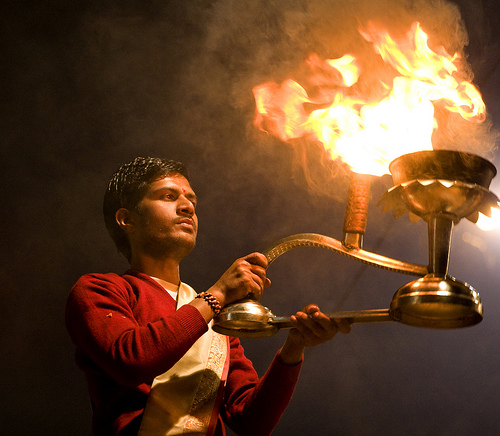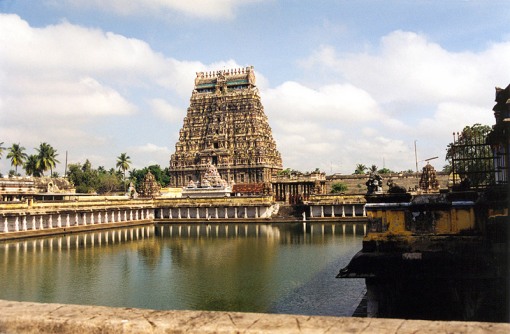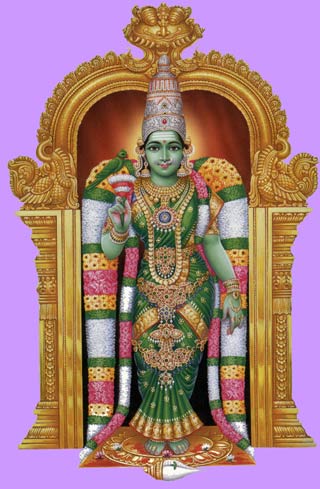Arrived in Kanchi on Sunday evening 16th August. Kanchipuram is known as the ‘Golden City of Temples’ and is considered one of the seven main sacred cities of India. It has over a hundred temples there today but is said to have had over a thousand. I saw four, two Visnu temples: the Vaikuntha Perumal Temple and the Varadaraja Temple and two Shiva Temples: The Ekambareshvara Temple and the Kailasanatha Temple.
It rained quite a bit on the evening and morning I spent in Kanchi so the bit about the’ Golden’ city was lost on me. It was all a bit sludgy so I decided on a whirlwind rickshaw tour of the four main temples. I had about one hour in each which is absolute blasphemy given how much there was to see, but I wanted to arrive in Tirumala before nightfall.
The first temple I visited, was the Vaikuntha Perumal temple, a Vishnu Temple, built in the 8th century by the Pallava king Nandhivarman Pallavamalla. It is unusual in having three sanctums, with Vishnu in reclining, standing and sitting pose respectively. I took darshan of Vishnu in his sitting pose and on ekadashi and festival days the other forms are open to the public.

Vaikuntha Perumal Temple Kanchi
The temple is small with grassy verges and the sounds of devotional music greet you as you step into its courtyard. There was only one other visitor there with me so the priest was very generous with his time and showed both of us around the inside of the temple.
He explained why the walls and carvings of the temple were so badly deteriorated. Apparently no one knows the exact mix of sandstone and other materials that comprise these walls and so cannot restore them.
With his blessings and some sweets, I left to visit a Shiva Temple, the Kailashanath Temple.

Vaikuntha Perumal
The Kailashanatha Temple is probably the most beautiful and best preserved of the four temples I visited in Kanchi. It is a small temple and also possibly the oldest, built in 7th century by Rajasimha Pallava.

Kailashanatha Temple
When I sought my rickshaw driver’s help in finding the concealed entrance to the inner sanctum on the side of the temple, he told me I could not go into the temple. Nonetheless we went in together and both my driver and I were met and welcomed by a most gentle Brahmin who, in impeccable English inquired about my pilgrimage and explained to us the details and story behind the huge Shiva Linga in the dark cavernous shrine.His family name was Subramanian, and his family have been priests there since the 14th century.
Unlike the Shore Temple at Mamallapuram, whose architecture it resembles, this temple, away from the eroding forces of the sea, seems to have survived incredibly well. The brahmin also shared his concern for the future maintenance of the temple due to lack of knowledge of the exact constituents of the sandstone edifice.
He also inquired whether or not education was corrupt in my country and then launched into a polite yet vehement criticism of the Indian Government’s ‘propaganda’ forcing people into technological and vocational fields of education. He decried the lack of interest in culture and traditional forms of learning.
It’s funny, I seem to remember a similar lament by Professor Gombrich at Oxford a few years ago. He would have had much to share with this little brahmin on the other side of the world. I left very happy to have met him and with my rickshaw driver urging me on to the next temple, The Shiva, Ekambareshvara Temple.
Ekambareshvara/Ekambaranatha Temple
This is the largest temple in Kanchipuram, and though parts of the main temple were built by the pallava Kings, the rest of the huge temple complex was built mainly in the 16th and 17th century. None of the gopurams (tower gateways) are opposite each other nor are the walls of the temple parallel to each other. For me this lack of symmetry created a sense of discordance. Or perhaps it was also because it was raining as I arrived with little time to appreciate its open spaces. I was glad to enter its inner hall ways.

Corridors of the Ekambareshvara Temple. I took the picture without my contact lens, as you can see.
At first I was refused entry to the inner sanctum by a rather pushy brahmin. When I mentioned the word ‘donation’ he changed his tune. Inside, although there were quite a few visitors, the brahmins at the shrine were welcoming and allowed me to take extra time viewing the Shiva Linga. It is made of sandstone and is believed to have been made by Parvati (wife of Shiva) and worshipped by her when she was separated from him.
There is also a mango tree (said to be about 3000 years old) here under which Parvati is said to have worshipped Shiva and performed penance for offending him. Naturally she won him over with her extra-ordinary feats and they continue to live happily ever after.

Parvati's Mango Tree
The Varadaraja Temple
The third temple I visited was this major Vishnu Temple built by the Kings of Vijayanagar in the 12th century. It is counted along with Tirupati and Sri Rangam as one of the major temples in South India.Varada means bestower of benedictions and raja means king.
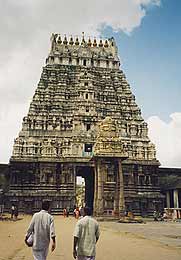
Entrance to the Varadaraja Temple
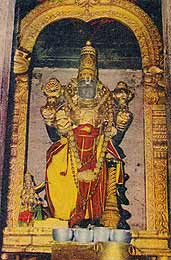
Sri Varadaraj
In this temple I had a brahmin guide who took me around the 1000 pillared hall with its myriad carvings from the Puranas and the Ramayana and showed me up the stairs of the small hill on which the deity of Varadaraj is located. It was not such a steep climb and the large, standing deity towers down upon all those ascending to pay their respects.

- Hanuman lifting mountain
The story is that Lord Brahma had Visvakarma, the architect of the demigods, make a wooden deity of Lord Varadaraja. The utsava-murti (festival deity ) is said to have emerged from Lord Brahma’s sacrificial fire. It was felt that the wooden deity would be ruined if constantly exposed and worshiped. Therefore the deity was immersed in the temple tank, and a granite deity was installed in its place. It is taken out for viewing every 40 to 50 years.The next time will be 2019 and the temple expects hundreds and thousands of pilgrims to flock here for this rare privilege.

Temple Tank
Kamakshi(Love-eyed) Amaan(Goddess) Temple
Finally I arrived at the Kamakshi Amaan temple and was a bit pessimistic about gaining entrance given my Meenakshi experience in Madurai. However, Nick (that’s Dr Nicolas Sutton to those of you who don’t know him) furnished me with the name of a Mr Shastri who had been very kind to him on his visit to the temple. So, as I was being ushered away from the entrance for being the freckled-pasty- skinned pariah that I am, I asked for Mr Shastri please.
A look of recognition in the eyes of the guard mellowed his approach into one of direction to the far corner of the temple. There, befittingly adorned with body paint and brahmin thread, sat Mr Shastri who never heard of Nick Sutton. ‘How many Mr Shastri’s are there ? ‘ I asked, and he laughed saying there were many, maybe 30. But the laugh may have mellowed him, or perhaps the potent vibration of the name Dr Nick Sutton did it, because he waved a hand towards the guard and told him to show me around.
So thank you Nick, for Mr Shastri. I’m sorry I never got to meet the gentleman himself, but I had a much appreciated guided tour of the Temple. I took no photographs, because I didn’t want to push my luck.
The temple is one of three main holy places of Goddess/Sakti worship in India, the other two being Madurai and Varanasi and was built by the Cholas in the 14th century.
Within the temple too there is a Vishnu shrine, The Varaha Perumal Temple, located just left of the entrance to the inner shrine which was the first place the guard took me, before showing me into the inner shrine where the Goddess is seated on a lotus. There is also a shrine to Shankara Acarya (who installed a chakra here) within the temple.
To further add to my good fortune, the bookseller at a bookstand without asking for any payment gave me free gifts of pictures of Kamaskhi, and a gold-coloured coin with Kuvera (the treasurer of the Gods) and Lakshmi (the Goddess of Fortune) on the other side. I thought the OCHS might benefit from this little blessing. Maybe we should install it somewhere in the centre.- Every little helps!
I left this final temple visit in Kanchipuram feeling very much blessed by the loving glance of Kamakshi and with prasadam ( sweets given out at all temples) bursting from plastic bags I raced off to collect my bag from the Hotel and catch a bus to Tirumala










